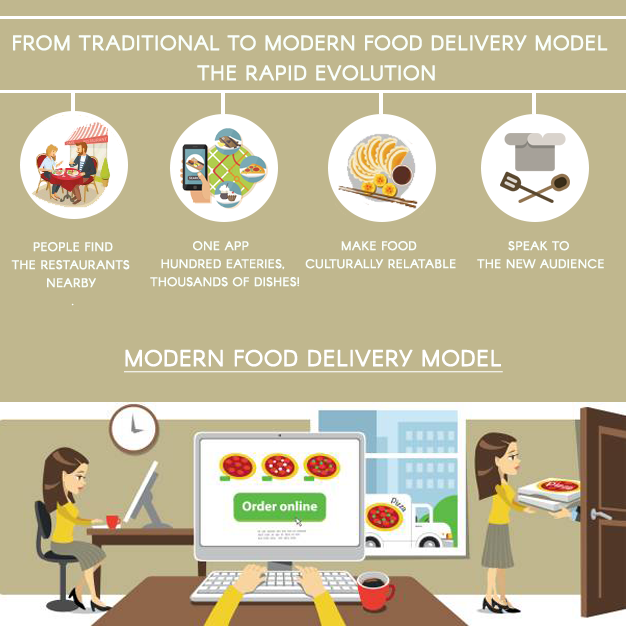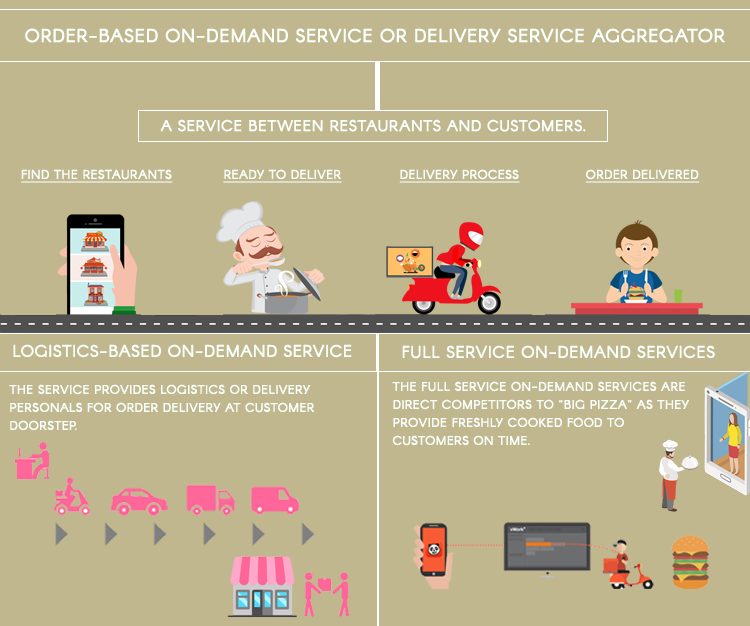Types and tussle between on-demand delivery platforms
What are you most likely to do when you come home all broke after office? Certainly, prepping up in kitchen is something you would mostly avoid. You will either have a help to do the grunt for you or you will most likely pick up your phone and order a delicious dinner right away!
Food Industry has grown by leaps and bounds over the last decade. People no longer drive to restaurants; instead exotic delicacies from renowned restaurants come galloping at their doorstep. Focus on consumer convenience has driven food industry to largely rely on web-based and mobile applications as they allow convenient order placement and faster doorstep delivery. Customers are now able to order multiple dishes from multiple restaurants within few taps using a single application. These on-demand delivery services help customers to:
- Rate and review the restaurants & the delivery services
- Pay more securely and conveniently
- Track the order processing from approval to delivery.
Popular food delivery services like Swiggy, Foodpanda, Runnr, Freshmenu etc have quickly engrossed the niche market by 41% encouraging investors to venture and contribute towards better growth. But, while this industry has attracted huge attention from investors, it is quite unclear what the future holds for this niche.
We bring to you three thriving business models that drive this sector with success today. We will see which model holds the best potential to cut through the competition and survive long into the future.
From traditional to modern food delivery model – the rapid evolution
Gone are the days when people used to look into a directory, scan through the names of restaurants nearby and note the phone numbers to make a call. Now, the digitalization has changed the scenario dramatically. Hundreds of restaurants are just a tap away! One app – hundred eateries, thousands of dishes! Just open your app, put your location, and a list quickly pops up showing restaurants nearby. You can choose from over thousands of dishes altogether and place an order – all you need to do is scroll and select your fantasy.
It is as simple as it is. But the app role doesn’t end here. You, actually, can see how your order is processing – right from restaurants approving your order to the delivery boy picking it up and driving all the way to your home!
Wait, the app scene has many more folds to go!
Recently, Dominos introduced “Zero Click” ordering as a standalone app that extended the “Anyware” ordering service. This app ensures that the user can order a pizza without even tapping! The app helps the user to link its profile where he can enter his favourite pizza names, his choice of toppings and crusts. Once the app is downloaded and the profile is linked, a pizza order automatically gets placed whenever the user opens the app. Well, you must be wandering what happens if it opens accidentally. Domino’s has a foolproof plan for that as well. After the app opens, it takes 10 seconds to finally place the order – where the user always has the liberty to cancel within 10 seconds.
In 2016, Dominos registered 55% of its total sales via mobile app ordering. Pizza Hut, too, registered 50% of its total sales via mobile apps.
The good news is, not just Pizza chains but there is a rapid growth of food delivery start ups that are giving a head-on competition to the “big pizza” scene. These start-ups are targeting millennial and crafting a business model that deliver freshly cooked food on demand. We’ve divided these on-demand food delivery services as:
- Order-based delivery service
- Logistics-based delivery service
- Full-service food delivery service
So let’s get started….
Order-based on-demand service or Delivery service aggregator
An aggregator or an order-based on-demand service works as a service between restaurants and customers. They offer customers access to various cuisines across various restaurants through a single website or app. Well, here the main focus lies on on-time order delivery and efficient customer support.
So, how does it exactly work? Once you sign in to the app or website, you can check out menus, prices, ratings and reviews. Based on your research of restaurants and wish to enjoy a cuisine, you place an order. The aggregator passes your order to the restaurant and then the restaurant prepares the dish and arranges for a delivery personnel to deliver your order on time. The aggregator has a fixed fee for every order which it deducts from the price of order placed and pays the rest of it to the restaurant.
Logistics-based on-demand service or new food delivery service
The business model here is quite the same as order-based on-demand service except that the service provides logistics or delivery personals for order delivery at customer doorstep. These types of services are highly popular as restaurants need not worry about vehicle maintenance, paying drivers and updating insurance policies for drivers and vehicles both. The service allows restaurants to focus on customer service and improve food quality rather than wasting a good amount of time planning on logistics. These types of services have helped various restaurants to cater to new customers in distant places. Eventually, they gained more visibility and also found a solid grip in new markets as well.
However, you might be wandering how these services cover the cost of logistics when there are hundreds of food couriers happening in a day and there are over hundreds of vehicles to maintain! Well, these services pose a fixed service charge on both restaurants and customers. It is quite surprising to know that despite high marginal costs, these new delivery platforms have achieved EBITDA (Earnings Before Interest, Taxes, Depreciation and Amortization) margin. The more restaurants collaborate with these platforms, the more profit they make.
Full service on-demand services
Well, this is quite interesting! The full service on-demand services are direct competitors to “big pizza” as they provide freshly cooked food to customers on time. They do not have third party alliances. They prepare food inside their own kitchen and hire in-house delivery professionals to deliver food to customer doorstep.
A very good example is Munchery – a full-stack take out solution in US. Customers can order a dish within an one hour window. Or, they can also pre-order an item a day before. The only catch here is, unlike the other two aforementioned models, the delivery here takes time – certainly because they prepare your order fresh in their own kitchen and then dispatch it for delivery using their own delivery fleet.
The app features a number of dishes, the ingredient required and the name of the chef preparing your order. The food arrives cold, yet contains heating instructions and serving kits.
The tussle – full-service Vs order-based Vs logistics-based services
Considering all the above features and the set of services, a full stack service certainly scores best between the three. They have full control over customer experience. From food preparation to delivery, they know what works best for which customer. They are able to deliver personalized service too which the other two fall short of. However, a full service on-demand delivery service can be a crunch for start ups as these services would require more capital and funding for a sustained growth. The services would require more employees and more equipment to grow their business, leaving alone the insurances and various business standards to comply with sanitary regulations.
The aggregator model is an ideal option for the businesses who step down to the market with less capital and funding. However, the competition is fierce and hence sustainability is a challenge. On the other hand, a logistics based on-demand delivery can face the challenge of tying up with restaurants – clearly because most restaurants have their in-house delivery services. However, when we precisely talk of all delivery models, the logistics-based delivery service has a better future. Why? Rightly because, they help restaurants reach new markets, enhance their services and engender better sales altogether.
Still have your concerns?
Your concerns are legit, and we know how to deal with them. Hook us up for a discussion, no strings attached, and we will show how we can add value to your operations!

